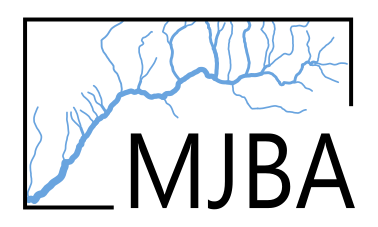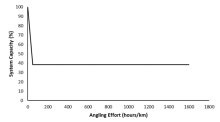Angling Effort and System Capacity
mbayly
View all records in the stressor response library
Species Common Name
Athabasca Rainbow Trout, Westslope Cutthroat Trout
Latin Name (Genus species)
Oncorhynchus mykiss, Oncorhynchus clarkii lewisi
Stressor Name
Angling effort
Specific Stressor Metric
incidental angling mortality and illegal harvest
Stressor Units
(hours/km)
Life Stage
Geography
Alberta foothills watersheds, excluding National Parks
Detailed SR Function Description
Derivation of the function:
Native trout were legally harvested throughout the eastern slopes prior to the implementation of the province-wide zero harvest regulation in 1995 for Bull Trout, 2014 for Athabasca Rainbow Trout and between 2009 to 2016 period for Westslope Cutthroat Trout (note: harvest may still be permitted on stocked or heavily hybridized populations). Angling may still represent a major threat to population sustainability due to incidental mortality (i.e., mortality due to stress or physical damage from hooking or handling) associated with catch and release fishing if angling effort and catchability is high (e.g., Post et al. 2003). Illegal harvest, either intentional or due to misidentification, occurs at an unknown frequency and may also contribute to population declines. Past case studies demonstrate that some Bull Trout populations are capable of recovering relatively quickly (5-10 years) from an over-exploited state under zero harvest regulations/reduced angler effort or complete angling closures (Johnston et al. 2007; Sullivan 2014).
In the absence of information on population parameters, such as catchability and abundance, angling effort (annual rod hours per km) was used as the stressor input value. Angling effort is considered a surrogate for fishing mortality; it is assumed that there is greater mortality at high levels of effort, and lower mortality and low levels of effort. The approximated relationship between angling effort and system capacity encompasses a linear decline in system capacity with increasing angler effort until an inflection point is reached where additional effort has no further impact on system capacity. The assumption is that there is a proportion of fish in a population that are less vulnerable or invulnerable to anglers, resulting in population resiliency albeit at lower abundance, i.e., fishing mortality alone is not expected to extirpate a population. This may occur because of reduced or variable catchability due to learned hook avoidance, heterogeneity among individual fish, and environmental factors (Askey et al. 2006, Van Poorten & Post 2011). Additionally, some fish may not be caught because anglers are unable to access all areas of a river system. These inaccessible areas provide a similar function to marine protected areas by reducing the proportion of the total population available to fishing (Cox and Walters 2002).
The species-specific shape of the stressor-response curve was based on a series of assumptions. First, we assumed that there was no impact to system capacity at zero angling effort (0 annual rod hours/km, 100% system capacity). Next, the x-coordinate of the inflection point was set at 18 annual rod hours/km for Bull Trout, based on Post et al. (2003) that predicted that angling effort above this value would not maintain a viable population of bull trout under catch-and-release regulations. For Westslope Cutthroat Trout this inflection point was set at 50 annual rod hours/km based on yield-per-recruit modelling that demonstrated a high potential for recruitment overfishing beyond this angling effort under catch-and-release regulations. Parameters used in this modelling exercise included a catchability coefficient of 0.015 (Sinnatamby et al. 2021) and 10% mortality due to both non-compliance and post-release mortality, similar to Post et al. (2003) (Reilly & Macpherson unpublished data). The critical angling effort value for Bull Trout is lower than Westslope Cutthroat Trout because Bull Trout exhibit life-history characteristics that make them more vulnerable to overexploitation (e.g., slow-growing, late-maturing, high catchability) (Johnston et al. 2007).
The y-coordinate of the inflection point was set as the 95th percentile of system capacity, calculated using all populations experiencing angling effort above the critical value. The 95th percentile was applied because it is expected that the relationship between system capacity and angling effort is better represented by the rate of change near the maximum response rather than the mean response, as system capacity is affected by multiple factors that may vary in their effect. This is similar logic to quantile regression that recognizes numerous unaccounted factors can be driving a response variable (Cade and Noon 2003). This produced inflection point coordinates of 18 annual rod hours/km and 36% system capacity for Bull Trout (Figure 1) and 50 annual rod hours/km and 38% system capacity for Westslope Cutthroat Trout. Species-specific fisheries models for Athabasca Rainbow Trout are not currently available. However, Westslope Cutthroat Trout and Athabasca Rainbow Trout exhibit similar life history characteristics and so the Athabasca Rainbow Trout inflection point was also set at 50 annual rod hours/km and 38% system capacity.
Native trout were legally harvested throughout the eastern slopes prior to the implementation of the province-wide zero harvest regulation in 1995 for Bull Trout, 2014 for Athabasca Rainbow Trout and between 2009 to 2016 period for Westslope Cutthroat Trout (note: harvest may still be permitted on stocked or heavily hybridized populations). Angling may still represent a major threat to population sustainability due to incidental mortality (i.e., mortality due to stress or physical damage from hooking or handling) associated with catch and release fishing if angling effort and catchability is high (e.g., Post et al. 2003). Illegal harvest, either intentional or due to misidentification, occurs at an unknown frequency and may also contribute to population declines. Past case studies demonstrate that some Bull Trout populations are capable of recovering relatively quickly (5-10 years) from an over-exploited state under zero harvest regulations/reduced angler effort or complete angling closures (Johnston et al. 2007; Sullivan 2014).
In the absence of information on population parameters, such as catchability and abundance, angling effort (annual rod hours per km) was used as the stressor input value. Angling effort is considered a surrogate for fishing mortality; it is assumed that there is greater mortality at high levels of effort, and lower mortality and low levels of effort. The approximated relationship between angling effort and system capacity encompasses a linear decline in system capacity with increasing angler effort until an inflection point is reached where additional effort has no further impact on system capacity. The assumption is that there is a proportion of fish in a population that are less vulnerable or invulnerable to anglers, resulting in population resiliency albeit at lower abundance, i.e., fishing mortality alone is not expected to extirpate a population. This may occur because of reduced or variable catchability due to learned hook avoidance, heterogeneity among individual fish, and environmental factors (Askey et al. 2006, Van Poorten & Post 2011). Additionally, some fish may not be caught because anglers are unable to access all areas of a river system. These inaccessible areas provide a similar function to marine protected areas by reducing the proportion of the total population available to fishing (Cox and Walters 2002).
The species-specific shape of the stressor-response curve was based on a series of assumptions. First, we assumed that there was no impact to system capacity at zero angling effort (0 annual rod hours/km, 100% system capacity). Next, the x-coordinate of the inflection point was set at 18 annual rod hours/km for Bull Trout, based on Post et al. (2003) that predicted that angling effort above this value would not maintain a viable population of bull trout under catch-and-release regulations. For Westslope Cutthroat Trout this inflection point was set at 50 annual rod hours/km based on yield-per-recruit modelling that demonstrated a high potential for recruitment overfishing beyond this angling effort under catch-and-release regulations. Parameters used in this modelling exercise included a catchability coefficient of 0.015 (Sinnatamby et al. 2021) and 10% mortality due to both non-compliance and post-release mortality, similar to Post et al. (2003) (Reilly & Macpherson unpublished data). The critical angling effort value for Bull Trout is lower than Westslope Cutthroat Trout because Bull Trout exhibit life-history characteristics that make them more vulnerable to overexploitation (e.g., slow-growing, late-maturing, high catchability) (Johnston et al. 2007).
The y-coordinate of the inflection point was set as the 95th percentile of system capacity, calculated using all populations experiencing angling effort above the critical value. The 95th percentile was applied because it is expected that the relationship between system capacity and angling effort is better represented by the rate of change near the maximum response rather than the mean response, as system capacity is affected by multiple factors that may vary in their effect. This is similar logic to quantile regression that recognizes numerous unaccounted factors can be driving a response variable (Cade and Noon 2003). This produced inflection point coordinates of 18 annual rod hours/km and 36% system capacity for Bull Trout (Figure 1) and 50 annual rod hours/km and 38% system capacity for Westslope Cutthroat Trout. Species-specific fisheries models for Athabasca Rainbow Trout are not currently available. However, Westslope Cutthroat Trout and Athabasca Rainbow Trout exhibit similar life history characteristics and so the Athabasca Rainbow Trout inflection point was also set at 50 annual rod hours/km and 38% system capacity.
Function Derivation
expert opinion, mechanistic theory
Transferability of Function
This function used data from Westslope Cutthroat Trout but was applied to Athabasca Rainbow Trout due to life history similarities. It should only be applied to scenarios where life history similarities and vulnerability to angling can be ascertained for the target species.
Source of stressor Data
The amount of angler effort was summarized as annual angling hours/km. When available, creel information was used to determine angling effort. In the absence of creel data, a model that incorporated the annual temporal and spatial availability of angling opportunities for the three species of native trout was used. This was achieved by estimating the hours of angling on weekdays and weekends for relevant lengths of native trout occupied streams (km) in a watershed. This was then summarized as an annual total by accounting for the number of weeks in an angling season.
Stressor Magnitude Data
Creel surveys
Function Type
continuous
Stressor Scale
linear
References Cited
Government of Alberta. 2024. Angling effort (incidental angling mortality and illegal harvest) stressor-response function for Athabasca Rainbow Trout and Westslope Cutthroat Trout. Environment and Protected Area Native Trout Cumulative Effects Model.
File Upload
SR Summary Document
(61.47 KB)
Data File
(16.83 KB)
Stressor Response csv data
Data_ARTR_angEffort_sysCapacity_1.csv
(123 bytes)
| Angling Effort (hours/km) | Mean System Capacity (%) | SD | low.limit | up.limit |
|---|---|---|---|---|
| 0 | 100 | 0 | 0 | 100 |
| 50 | 38.3 | 0 | 0 | 50 |
| 1600 | 38.3 | 0 | 0 | 50 |
Stressor Response Chart

